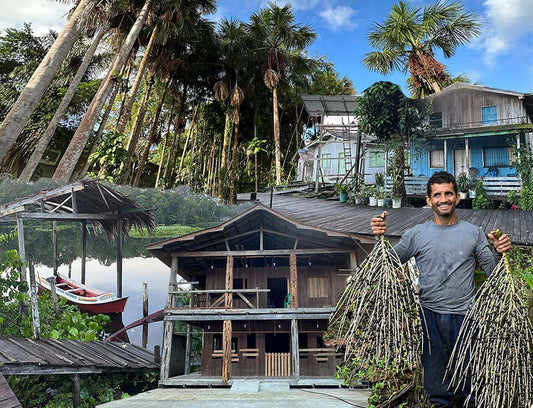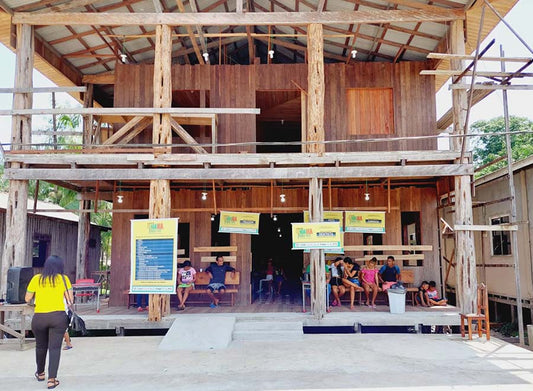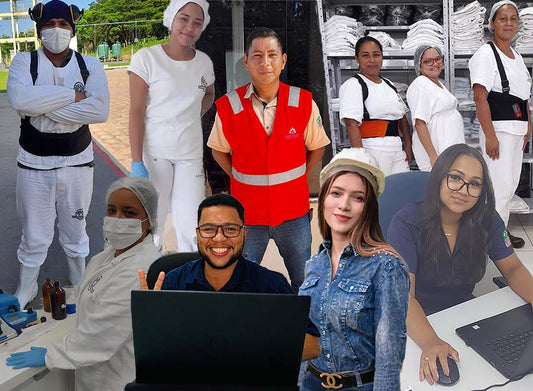We are proud to announce that a Biodiversity Study, spearheaded by Dr. Gabriel Damasco, Ph.D. from UC Berkeley and his team of US and Brazilian researchers, has been accepted and published in the Journal of Agroforestry Systems at the beginning of 2022. The title of this research article is: "Certification of Açaí agroforestry increases the conservation potential of the Amazonian tree flora." The key findings of the research paper are:
- Unregulated extraction in Amazonia can have negative environmental effects, and the use of certified sustainable agroforestry can help reduce the exploitation of Amazonian forests.
- On average, certified managed forests harbor 50% more tree species.
- The trees in certified areas are larger, and hence older individuals are more likely to be protected and provide more habitat for other animals and plants.
- Lastly, certified harvesting sites have dense populations of threatened species.
If you’re intrigued by what you’ve read so far, dive into the details below and see how the science was conducted, and learn about more interesting discoveries from our research team!
Why did we provide a research grant to conduct this study?
Global Compliance Director Mandy Anhalt explained, "We choose to offer a research grant to further develop our knowledge of the biodiversity in areas in which our Açaí is wild harvested. We wanted to create a baseline for the ongoing monitoring of the impact that our certified harvesting activities are having on the flora and fauna in this region." As a company, we aim to have a mindset of continuous improvement: one in which we walk the talk by proactively and actively measuring our impact and delivering on our mission and values. We are constantly working to ensure that our network of harvesters receives the training needed to follow our consciousness efforts, organic and fair trade practices, and commitment to have a positive impact on the Amazon Rainforest.
To accomplish this, SAMBAZON Inc. offered a $35,000 USD competitive research grant for the independent study of biodiversity in the wild harvest Açai environment. Our focus is on our Fair Trade and organic certified areas in the Amapá and Para states of Brazil, but our interest is in the overall effects of Açaí harvesting in the entire Amazon region.
We want to ensure the Açaí harvested for SAMBAZON is sustainable and we look to these three indicators to ensure our work is doing just that.
- Improved livelihoods for local forest residents
- Conservation of intact forests that harbor high biodiversity
- Prevention of deforestation that exacerbates global climate change
Dr. Damasco’s research worked to help validate the last two points and we are happy to share our process and his thoughts on his research here.

Who was chosen to conduct the research?
We were looking for experienced and well-regarded scientists who had experience working in the Brazilian Amazonian Rainforest. In addition to being knowledgeable researchers we also needed a team that would have an inclusive approach to working with our local experts in the harvesting communities. Our intention with this study was to fund an independent team that could survey and catalog the biodiversity in the forest without bias so that we could have a better understanding of how our practices affect the rainforest.
The field of applicants was competitive, and choosing from the many qualified individuals wasn't an easy task. However, our Grant recipient was extremely deserving and well suited for this project: Gabriel Damasco, Botanist, Ph.D. in Integrative Biology, University of California Berkeley. He has experience in taxonomy, ecology, and evolution of the Amazonian flora. Luckily for us, he is also from Brazil, already had numerous papers published about our area of study, connections with researchers in Brazil, and coming from UC Berkely, a world-renowned Biological Science University, his credentials were the most impressive. SAMBAZON is very pleased to support his ongoing work in the Amazon.
When asked why he pursued this research grant, Dr. Damasco said that “As a nature enthusiast and botanist in Brazil, I was keen to apply for the SAMBAZON Biodiversity Grant to develop a study to help understand the impact of Açai production in the Amazon flora and how certification could benefit biodiversity conservation.”
Dr. Damasco compiled a team of US and Brazilian researchers with experience in Botany, Ornithology, Mammalogy, Entomology, and general rainforest biology. “I searched for a team of well-known researchers and Ph.D. students with long experience in doing fieldwork in the Amazon and Brazil. Some of them have been working with me for a long time in the Amazon,” explained Dr. Damasco. They have conducted 2 field expeditions and have now published their first peer-reviewed scientific paper on their work.

How was the research conducted?
As a general biodiversity study, this research determined tree species composition and forest structure of Fair for Life certified Açaí harvesting areas in eastern Amazonia. The certified harvesting sites was are commonly located along the river edges. The research performed using the Biodiversity Grant included both plants, animals, and Açaí pollinators, however, the paper that was published includes only preliminary information on the tree species composition and forest structure. Any potentially threatened or endangered species were noted to help SAMBAZON and the harvesting community understand if there were any species that we should pay particular attention to. The results were then compared with previously published data on non-certified Açaí plantations and transects in intact Amazonian flooded forests. This study was recently updated in 2021, further adding to the concern that non-certified and unregulated Açaí management could threaten the biodiversity of the Amazon floodplain forest.
In these field expeditions, our researchers also performed interviews with residents and visited different harvesting lands before sampling. They classified the management intensity of the forest based on three factors: i) the harvesting frequency, ii) the density of Açaí palms, and iii) the number of years that areas have been managed, which covered a spectrum from low and recent too high and long-term intensities.

Birds, mammals, amphibians and reptiles were sampled with observations, scat, sign, tracks, vocalizations, and camera trap methods, and individuals were identified to the species level. The bird survey was done through observations starting at sunrise, around 5:30 a.m. to 12:00 p.m., and from 3:00 p.m. to 5:00 p.m. Whenever possible, individuals were recorded and photographed. The sampling corresponds to very silent and slow walking, looking carefully for animals on litter, tree trunks, dead trunks, soil, under tree barks, termite nests, and other typical shelters usually used by other animals. Cameras with moving sensors were installed to track mammals over the course of three days. Finally, the pollinator community was sampled by using GoPro cameras placed on top of Açaí palm trees to record the insect community diversity and frequency of Açaí flower visitors. As the first published paper only covers tree species composition and forest structure, our researchers are planning on publishing results on animals and insects soon.
We are hoping to conduct more research in the future, as these first study results have only provided more ideas for future projects. One of the ideas Dr. Damasco has would be to set up controlled plots by “conduct sampling in non-certified lands nearby the certified plots. A precise way of testing the benefits of Açaí Fairtrade certification would be temporarily monitoring permanent certified and non-certified plots and observing the effects and benefits of certification over a long-term time.”

What did the research find?
On average, certified managed forests harbored 50% more tree species. Trees in certified areas were larger and hence older individuals are more likely to be protected and provide more habitat for other animals and plants. Based on the research conducted, our team found that certified Açaí management is not compatible with outright deforestation, instead, it is an agricultural practice that preserves natural habitat and maintains forest structure mostly intact, as well as the ecosystem services provided by the forest (e.g., climate regulation, water resources, carbon sequestration). Also, Açaí palms are “pioneer species” that can grow in disturbed habitats, stabilizing the area and facilitating the growth and establishment of other long-lived trees that support mature forest stages.
Certified harvesting sites also have dense populations of threatened species: “We registered three threatened bird species based on the IUCN updated list: the festive Amazon (Amazona festive) and the gray hatchback (Thamnophilus nigrocinereus), and the Tucano-de-white-throat (Ramphastos tucanus), all endemic to the Amazon region. We also registered jaguar footprints and photographed using our camera traps a rare anteater that looks very similar to a newly, but not yet described, species from the area,” said Dr. Damasco.

Many native tree species that are commonly used as food and medicinal resources are also found in the harvesting areas. It was no surprise that our researchers found that the local landowners are knowledgeable about the importance of keeping the useful native trees alive. As Dr. Damasco described, “it is simply intriguing to learn about the reality and life routine of Açaí producers. These local people know their forests very well. This kind of empirical knowledge is not conceived at universities or schools. If these producers are oriented in the right direction, the conservation of the Amazon could be much more effective.”
Dr. Damasco found it “surprising that, despite the lack of a temporal monitoring assessment in our experimental setup, we identified that managed sites after 12 years of certification had a higher species richness than non-certified groves. Additionally, the forest structure of certified sites was considerably more intact compared to non-certified areas.” Therefore, an intermediate and regulated management of Fair Trade Certification could increase the conservation potential of native trees in Açaí harvesting areas. We hope to do more research into this hypothesis as these results are very encouraging.

Why does this matter?
As Dr. Damasco explains, “Given the rampant habitat loss and reduction in forest biodiversity due to recent Açaí expansion, an innovative strategy for sustainable agroforestry management is urgently needed to prevent biodiversity loss and deforestation. Currently, the Açaí market in Brazil lacks a clear and uniform policy that regulates the promotion of biodiversity conservation in harvesting areas.
In tropical countries, such as Brazil, third-party certification could play an important role considering the negative effects of a growing commodity production, and the need for governmental capacity and resources to regulate agriculture effectively. With the increasing public, governmental, and corporate interest in sustainable consumption, it is important to understand the contribution of sustainable agroforestry and certification in promoting biodiversity conservation.”
SAMBAZON will continue to pursue and practice certified sustainable practices that in turn protect the richness and diversity of the Amazon environment that we utilize to bring you the Delicious Powers of Açaí. Dr. Damasco put it best when he said “We are urged to find a more integrative way to effectively protect the biodiversity in the Amazon. Our society, industry, and government need to work jointly and solve it together. As exemplified in our study, certified Açaí agroforestry may provide many environmental and social benefits. It can improve livelihoods for residents, promote conservation of forests that harbor high biodiversity, and prevent unregulated deforestation that, in turn, exacerbates global climate change.”
This study contributes to the knowledge about the biodiversity of the Várzea forests of the Amazon Basin. Dr. Damasco explained that “to date, there are very few studies like this from Amapá and Pará regions. With our study, we were able to establish research plots in areas never sampled before. Also, we have used sampling methodologies compatible with protocols used by researchers worldwide and our results could potentially contribute to larger-scale biodiversity studies.”

Full List of Authors: Gabriel Damasco, Ph.D., Mandy Anhalt, M.S., Ricardo O. Perdiz, Ph.D., Florian Wittmann, Ph.D., Rafael L. de Assis, Ph.D., Jochen Schöngart, Ph.D., Maria T. F. Piedade, Ph.D., Christine D. Bacon, Ph.D., Alexandre Antonelli, Ph.D., & Paul V. A. Fine, PhD







Comments
(0 Comments)Please note, comments need to be approved before they are published.